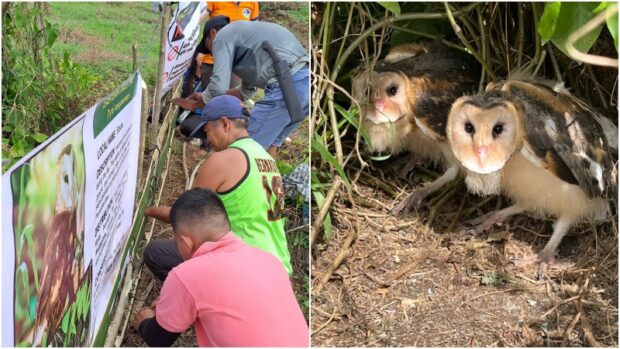Eastern grass owls found nesting in Cotabato town

PROTECTION | Personnel of the Department of Environment and Natural Resources in Soccsksargen region and village officials install last week a fence to protect the two Eastern grass owls found in the upland village of Luna Norte in Makilala, Cotabato, on March 20. (Photos from the Facebook page of the DENR)
COTABATO CITY, Maguindanao del Norte, Philippines — Environment officials have allowed a farmer in a small village in Cotabato province to take care of two juvenile female eastern grass owls (Tyto longimembris) found in his farm lot in Makilala town.
Afredo Bas, a farmer in the town’s Barangay Luna Norte, found the owls on March 20, nesting in a cluster of Arrowhead plant (Syngonium podophyllum) on his property and immediately sought the help of village officials and the Department of Environment and Natural Resources (DENR) personnel on how to handle them.
Bas said he wanted to bring the owls to the Provincial Environment and Natural Resources Office (Penro) here but he was worried he might get arrested for transporting endangered wildlife.
It was Barangay Luna Norte Chair Alfredo Barnadas who later informed the Penro about the find before he checked on the birds.
Fenced off
Khadija Bayam Benpolok, head of the regional strategic communication and initiatives group of DENR in Soccsksargen, said they found the owls to be healthy and did not want to move them to the DENR wildlife rescue center to avoid stressing the animals.
Article continues after this advertisement“The physiological features of the owlets are generally in good condition and in a safe environment,” he added.
Article continues after this advertisementAs long as the site was secured and properly identified as a nesting site of the birds, the owls could stay within the area, Benpolok said.
To protect the owls, the farm owner and village officials fenced off the site and put up a tarpaulin identifying the area as nesting site of the owls.
Declining
The Eastern grass owl is not considered to be an endangered or vulnerable species, but their number is believed to be declining, according to Birdlife International, a global group of nongovernmental organizations involved in the conservation of birds and their habitats.
The grass owl’s most common prey are farm rats; hence, they usually thrive in rodent-infested farms. The owl uses its long legs to penetrate the thick grass where their prey usually hide. Owls are nocturnal animals; hence, they sleep during the day and hunt food at night, the DENR said.
Village officials and local residents also helped Penro personnel in installing the bamboo fence to secure the nesting site.
Barnadas said residents of Barangay Luna Norte expressed their commitment to protecting the Eastern grass owl and other wildlife in the area.
Lawyer Felix Alicer, the region’s DENR director, said he was glad that the public in the Soccsksargen region had been helping the DENR in wildlife protection.
On March 22, DENR personnel freed three critically endangered Mindanao hanging parrots, commonly known as “colasisi,” in the town’s Barangay Spring that were surrendered by a villager.